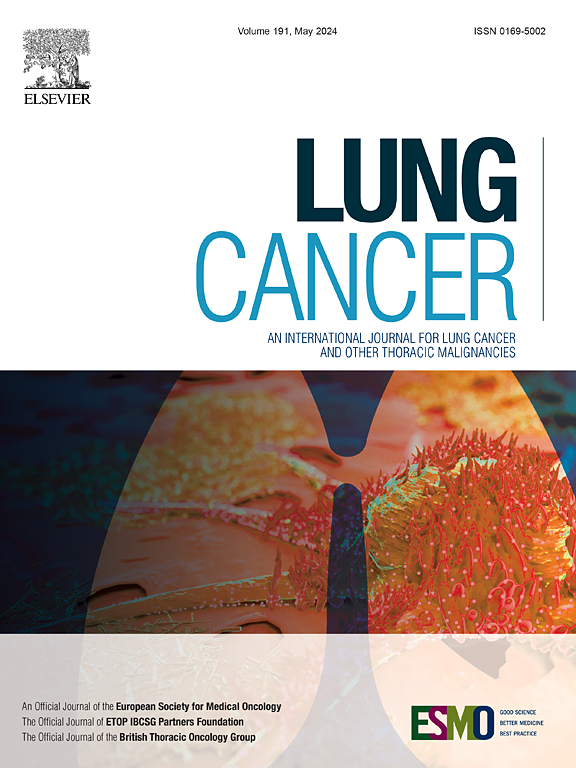Prognostic impact of extracapsular extension of lymph nodes in resected lung cancer: analysis by new N subcategories and histologic types
IF 4.4
2区 医学
Q1 ONCOLOGY
引用次数: 0
Abstract
Objectives
Despite being an R1 descriptor, the effects of extracapsular extension (ECE) on survival are inconsistent and remains invalidated under N2 subcategorization (pN2a and pN2b). This study aimed to validate the survival effect of ECE across N subcategories and histologic types.
Materials and methods
Patients who underwent lobectomy or pneumonectomy for NSCLC between 2010 and 2022, with proven pN-positive status and Union for International Cancer Control R0 designation, were retrospectively included. Effect of ECE on overall survival (OS) and recurrence-free survival (RFS) was assessed using multivariable Cox proportional hazard models, while that on recurrence patterns (locoregional vs. distant) was assessed using Fine–Gray subdistribution hazard models.
Results
Among 1713 patients included, the prevalence of ECE increased with the pN category: 11.6 % in pN1 (87/751), 17.6 % in pN2a (104/581), and 44.6 % in pN2b (170/381). ECE was an independent risk factor for poor OS and RFS in all pN-positive patients, after covariate adjustment (all p < 0.05). Patients with ECE consistently exhibited higher risks of mortality and RFS events compared to their ECE-negative counterparts across pN1, pN2a, and pN2b (all p < 0.05). Upon stratification by histologic type, ECE exhibited negative effects exclusively in adenocarcinoma (all p < 0.05), not in non-adenocarcinoma (all p > 0.05). ECE was an independent risk factor for locoregional recurrence (p = 0.002) but not for distant recurrence (p = 0.090).
Conclusion
ECE demonstrated a negative effect across pN1, pN2a, and pN2b, validating its role as an R1 descriptor. The negative effect of ECE exclusively in adenocarcinoma highlights the need to interpret ECE status with respect to histology.
肺癌切除后淋巴结囊外延伸对预后的影响:新的N亚类和组织学类型分析。
目的:尽管作为R1描述符,但囊外延伸(ECE)对生存的影响是不一致的,并且在N2亚分类(pN2a和pN2b)下仍然无效。本研究旨在验证ECE在N个亚类和组织学类型中的生存效果。材料和方法:回顾性纳入2010年至2022年间接受非小细胞肺癌肺叶切除术或全肺切除术的患者,证实其pn阳性状态和国际癌症控制联盟R0指定。使用多变量Cox比例风险模型评估ECE对总生存期(OS)和无复发生存期(RFS)的影响,而使用Fine-Gray亚分布风险模型评估ECE对复发模式(局部区域vs远处)的影响。结果:在纳入的1713例患者中,ECE的患病率随着pN类型的增加而增加:pN1为11.6% (87/751),pN2a为17.6% (104/581),pN2b为44.6%(170/381)。协变量调整后,ECE是所有pn阳性患者OS和RFS差的独立危险因素(均p 0.05)。ECE是局部复发的独立危险因素(p = 0.002),但不是远处复发的独立危险因素(p = 0.090)。结论:ECE在pN1、pN2a和pN2b中表现出负作用,验证了其作为R1描述符的作用。ECE仅在腺癌中的负面影响强调了从组织学角度解释ECE状态的必要性。
本文章由计算机程序翻译,如有差异,请以英文原文为准。
求助全文
约1分钟内获得全文
求助全文
来源期刊

Lung Cancer
医学-呼吸系统
CiteScore
9.40
自引率
3.80%
发文量
407
审稿时长
25 days
期刊介绍:
Lung Cancer is an international publication covering the clinical, translational and basic science of malignancies of the lung and chest region.Original research articles, early reports, review articles, editorials and correspondence covering the prevention, epidemiology and etiology, basic biology, pathology, clinical assessment, surgery, chemotherapy, radiotherapy, combined treatment modalities, other treatment modalities and outcomes of lung cancer are welcome.
 求助内容:
求助内容: 应助结果提醒方式:
应助结果提醒方式:


